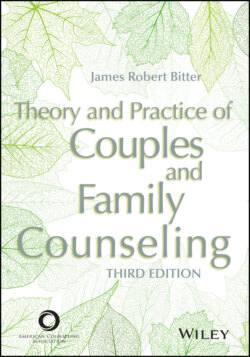Читать книгу Theory and Practice of Couples and Family Counseling - James Robert Bitter - Страница 37
Suggestions for Using the Book
ОглавлениеI have attempted to write this book as if we were having a conversation. It still contains all the references you will need to further consider each topic, but its most important function is to invite you into the world of couples and family counseling and to consider whether this kind of work is right for you. Any kind of work in the helping professions, whether it is counseling, psychotherapy, or family practice, requires personal development as well as professional skills. There are many professions in which it is possible to be competent without addressing who we are as people—for example, engineering, visual arts, mathematics, or the sciences—although even these career fields are enhanced by personal develop ment and growth. In the helping professions, and especially in family practice, who you are as a person is central to everything you do: You are the instrument that provides the catalyst for change.
As you read each chapter, consider how it applies to your own life, your own experiences, and your own worldview or perspectives. Can you see yourself approaching clients in the way that each of the models in this book suggests? Which techniques would you find comfortable, and which would be a stretch for you? What can you learn about your own family of origin from studying each of the theories in this book? Do they help you change any of the ways in which you approach family members now? What would it be like for you, as a client, to go see each of these family practitioners? And most important, what would it say about you as a person and as a professional to be part of a profession in family counseling?
The integration chapter presented at the end of the book relies in part on the development of different perspectives or lenses in counseling practice. These lenses (sometimes called metaframeworks; Breunlin et al., 1997; Pinsof et al., 2018) allow you to consider a couple or family from many angles and to develop a more holistic, context-embedded view of the family and its members. Different approaches will help you assess and understand the purposes for which couples and families interact; their communication processes; sequences or patterns of interaction; the organization and rules that govern the family; the developmental stages of the family; and the gender, cultural, and societal issues that may be affecting client relationships. And all of them will have some impact on how you develop your own self-awareness.
I often think of multiple perspectives in the same way I might look at a tree—or any object for that matter. At a great distance, a tree looks almost flat, as if it were painted against some pastoral background on a canvas. As I approach the tree, it begins to take on shape and texture; I can see the cylindrical roundness of its trunk and limbs, the shape of the leaves, and even the texture of the bark. When I get close enough to touch the tree, I can feel the differences in these textures and imagine its history, how long it has been here, and what it has been through to attain the shape and posture that it currently holds. I can walk around the tree, and in some cases I can even crawl up into it. I can feel the muscles in my own body stretch and contract as I pull myself up from limb to limb. I can feel the wind blowing through the tree and over my face and hands. For a while, I am part of the tree, and still I am different and not part of the tree.
Although this metaphor works for me in terms of thinking about the many perspectives that can aid me in knowing and understanding a couple or family, it also invites me to consider my relationship to the tree in terms of change. Should I simply get to know the tree and then let it be? Do I think of it as a tree I just happened to encounter, or is it a tree placed in my care? Does it need pruning, and, if so, in what way? Does it need fertilizer, and, if so, what kind and how much and at what time in its development? Is it indigenous to the area in which it is rooted and in the company of other trees just like it? Or has the tree been transplanted from another place, another climate, or another context? Would I see this tree differently if I were different—for instance, if I were not a man but a woman, or if I were not oriented toward an individual tree but rather saw this tree in relation to all other trees in the area or that had ever been? Am I stretching this metaphor too far?
I wonder what metaphor for working with couples and families you could generate. I also wonder whether the metaphor will be the same or different when you finish reading the various theories presented in this book. Imagining is not such a bad way to start any journey. What do you imagine couples and family practice might be like?
